
Le Multipin rings with gorgeous tourmalines from Bravery Chapter II high jewelry collection, Louis Vuitton
Tourmaline was already known to Greek philosophers as early as 300 BC. Even though the portrait of Alexander the Great was carved into a tourmaline more than 2300 years ago, the mineral was neglected by both scientists and gem traders.
2000 years to be accepted as a true gem
Mixed with other stones, tourmalines of various colors were largely doomed to anonymity by being traded as “Ceylon stone” or other fancy names. Toramolli in Sinhalese translates as “stones of other colors”. This term was used in Sri Lanka for the many gemstone species other than sapphire, ruby, or chrysoberyl, recovered from the island’s rich gem-gravels.
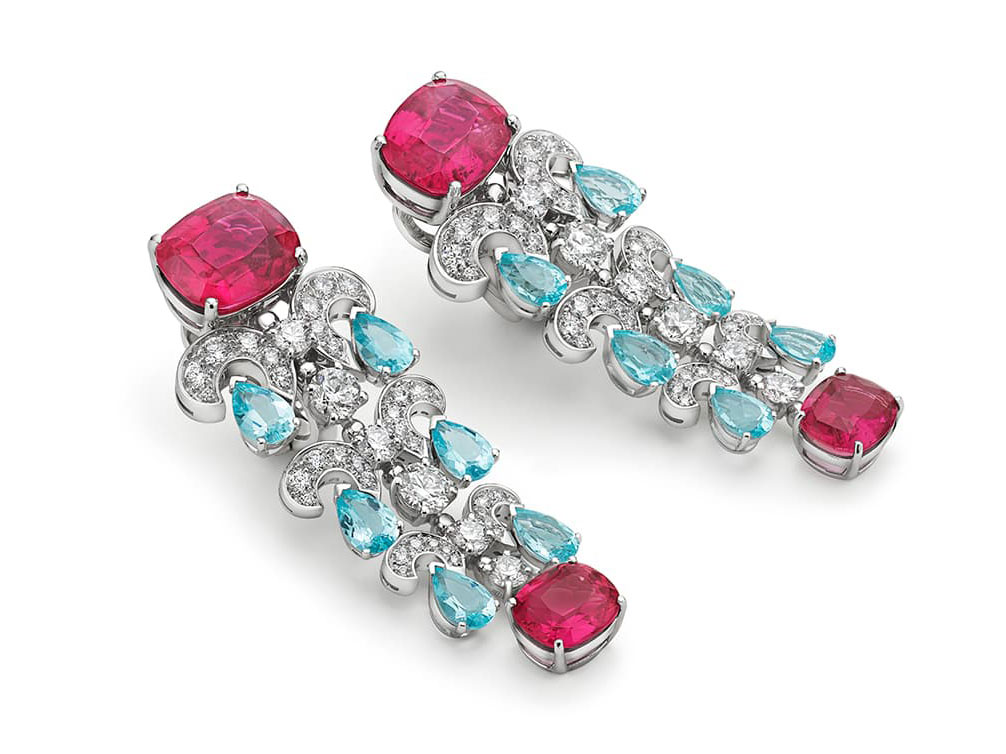
Earrings with Paraiba tourmalines, rubellites and diamonds, from Colour Journeys high jewelry collection, BVLGARI
Purple and red to pink rubellite was probably the first tourmaline variety to receive some recognition. Till they were correctly identified, red gemstones such as ruby, spinel, garnet, and rubellite, were all grouped under the term “carbuncle”.
Believed to be exceptional rubies, large rubellites from Central Asia and Brazil were incorporated into Europe’s regalia, like the 255-ct “Zarina Katharina Ruby” which was later identified as red tourmaline.
Mother Nature cooks in a dirty kitchen

Gem-bearing Pegmatite with crystals of Paraiba tourmaline, Brazil. Photo: (c) Roland Schluessel (1996)
Tourmaline is the author’s favorite gemstone. Not only because of the infinite color possibilities that cover the whole range of spectral hues, but particularly because tourmaline grows into spectacular prisms and crystal clusters that surpass any other gem in magnificence and diversity.
It is its extremely complex chemical composition, with the ability to substitute some elements with others, that alters its chemistry and creates more than 40 tourmaline species. Despite only a handful of them are regularly encountered as gemstones in jewelry, tourmaline covers the whole color spectrum and more: due to chemical variations during crystal growth, tourmaline can display several different colored sections on the same gemstone.
Mother Nature cooks in a dirty kitchen, and tourmaline is the finest illustration of it. In fact, its mineralogy is so complex, that the gem trade identifies tourmaline varieties according to color rather than mineralogical type. Thus, a red or purple tourmaline is identified as rubellite, no matter to which tourmaline species it belongs to.

A cross section of tourmaline from Luc Yen, Vietnam. Photo: T.Häger for GIA
Most gem tourmalines are lithium-rich tourmalines. Lithium was, after hydrogen and helium, the third element that formed during the creation of our Universe following the “big bang” 13.7 billion years ago. All other elements were conceived much later as a result of collapsing stars and powerful stellar explosions.
Imagine that the precious tourmaline set in your jewelry contains the first metal element dating back to the creation of our universe!
Born from pegmatites and highly associated with high-tech

Bracelet with tourmalines and cubic zirconia, PNJ
Now that tourmaline holds the well-deserved recognition as a gemstone, it is promised a bright feature. Next to its wide range of attractive colors and good durability, new discoveries of tourmaline were recently made in Africa, Asia, and Brazil.
Most gem-tourmaline are mined from granitic pegmatites which are the identical source as the elements that are indispensable for the leading technologies of the 21st century.
Hard-rock lithium, beryllium, boron, rare earth elements and many other essential elements are extracted simultaneously with tourmaline, beryl, spodumene, topaz, quartz, and mica from pegmatites from around the world.
These elements are now considered strategic by many governments because of their significance for a nation’s economic and national security. No electric car, computer, smartphone, wind turbine, and other devices work without utilizing these elements from pegmatites.
Increasing consumption of these commodities will lead to more pegmatite mining, which in turn should result in more exciting
The kaleidoscopic gem “par excellence”

Platinum ring with rubellite flanked by a pair of pink sapphires, Paolo Costagli
One of the most popular tourmalines is the red rubellite, particularly in China where red is regarded as an auspicious color.
In the traditional western marketplace, tourmaline once had the reputation of a low-priced stone that was not more attractive than a dark green glass bottle. Times have changed, consumers now favor bright green and blue-green tourmalines that are not overly saturated.

Platinum pendant with diamonds, featuring an emerald-cut green tourmaline, Tiffany & Co
Thanks to recent discoveries, amazingly beautiful green, blue-green, and blue tourmalines are available to color enthusiasts. Unlike the common dark tourmalines, the much rarer bright green tourmalines ranging from mint-green to emerald-green can be cut in oval, round, and cushion shapes without being obscured by the dark dichroic color that characterizes many tourmaline varieties. However, these stones with a better low-light performance are valued at several hundreds and even thousands of U.S. Dollars per carat.
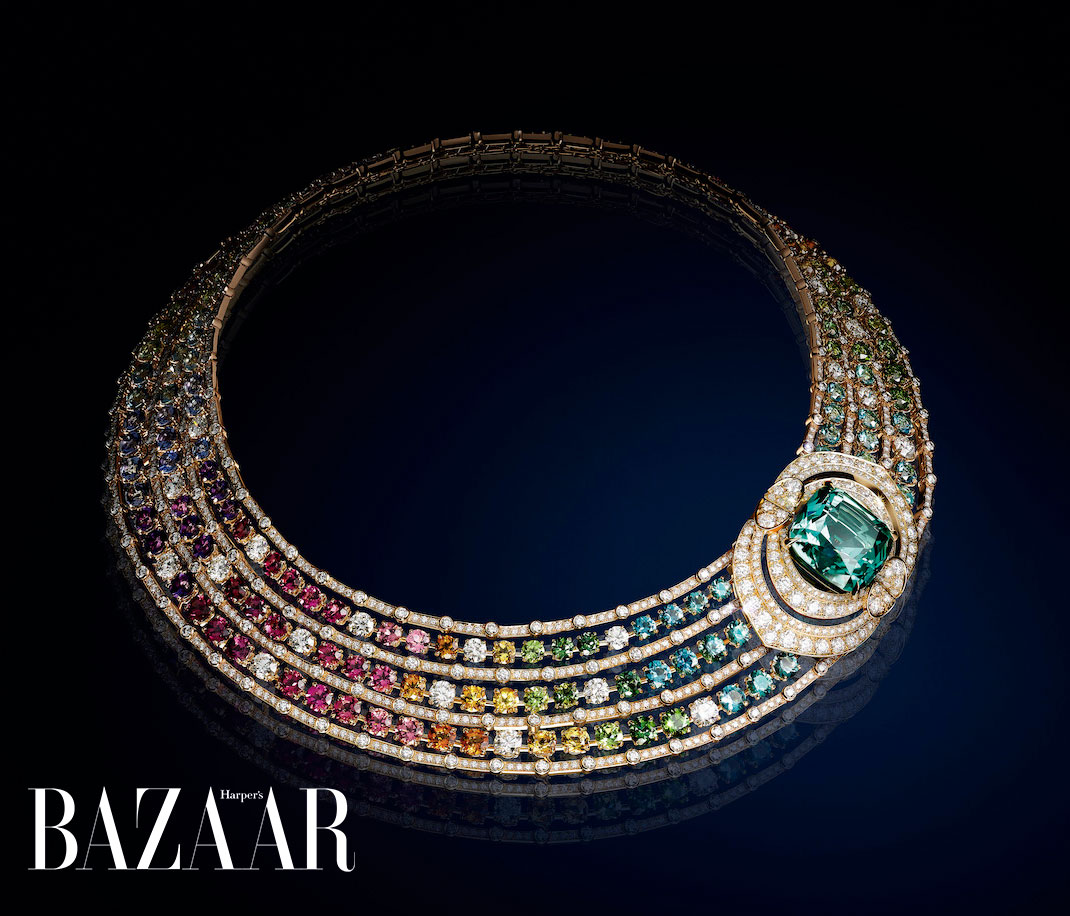
Le Multipin necklace from Bravery Chapter II collection features a “lagoon blue” tourmaline exceeding 40 carats, supported by rows of pink and green tourmalines, citrines, aquamarines, tanzanites, and diamonds, Louis Vuitton
Unlike rubellite that tends to contain visible inclusions, tourmaline can be quite clean. Blue indigolite is one of the rarest colors in the kaleidoscope of tourmaline; it rarely occurs in large crystals and even more rarely in a color saturation that is not too dark.
Clean and bright indigolite is particularly scarce and highly sought-after; its market value is accordingly high. Darker indigolite usually shows an obscuring black component due to a directional darkness, color over-saturation, and extinction. The finest indigolites are commercially mined in Brazil, Namibia, and Afghanistan, but other nations produce attractive blue material too.
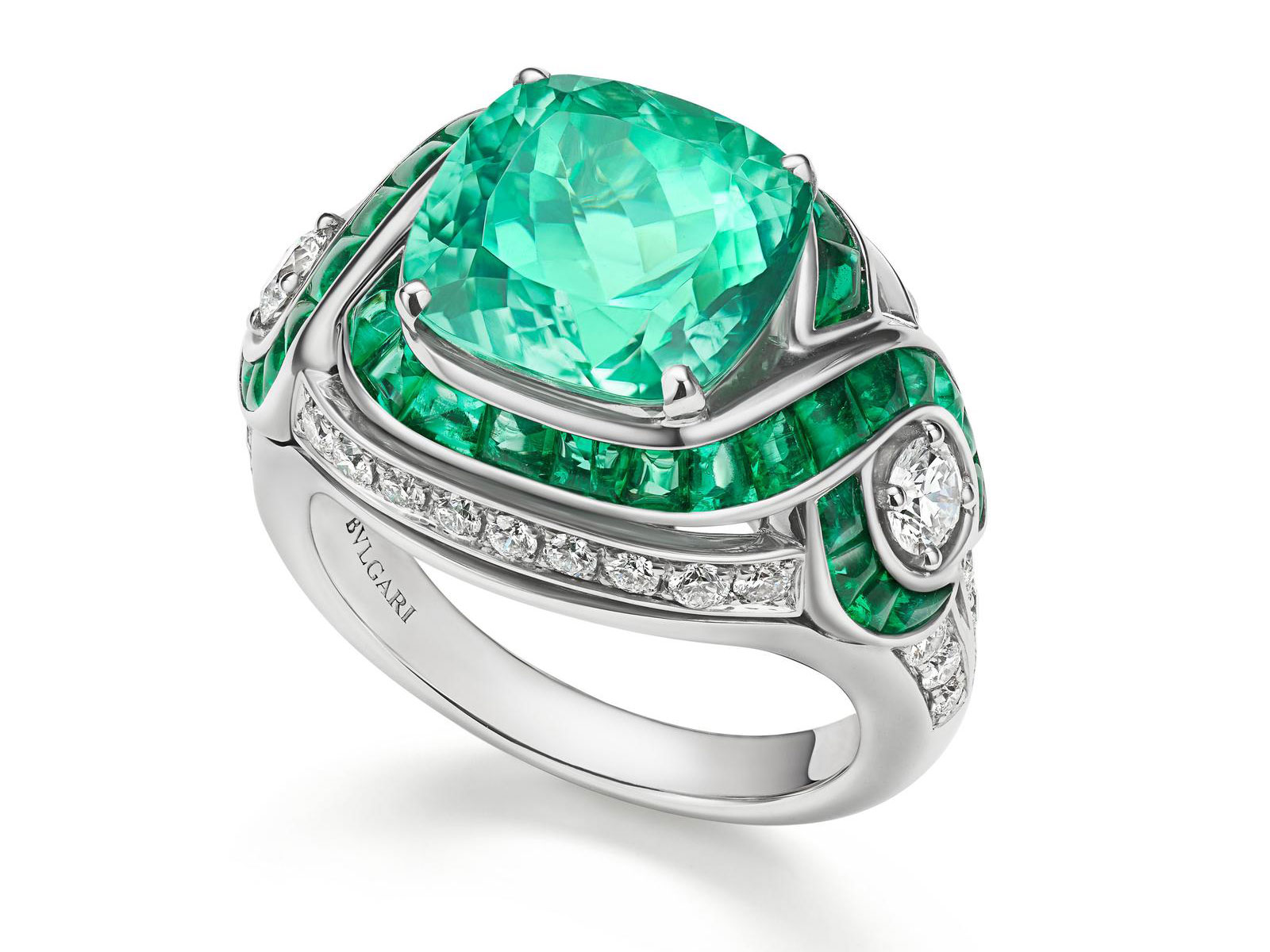
Lagoon tourmaline ring from Colour Journeys high jewelry collection, BVLGARI
Particularly bright and clean blue-green to greenish blue tourmalines of medium saturation have been discovered between 2015 and 2022 in new deposits in Brazil, Namibia, Mozambique, and some places still kept secret. The most exceptional of these new tourmalines can closely resemble Paraiba tourmaline and are referred to as “lagoon” tourmaline.
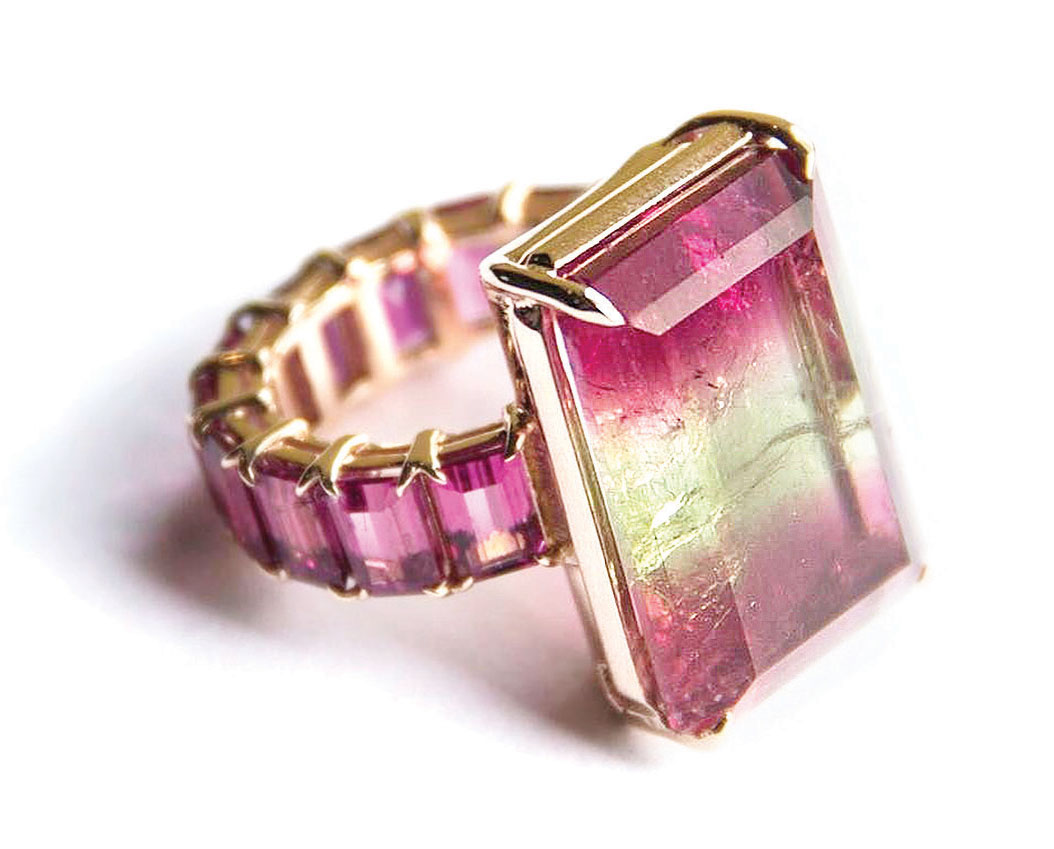
Watermelon tourmaline ring, Silvia Furmanovich
Pink tourmaline is more common than rubellite, as it is a paler representation of red. Africa produces a great variety of mixed hues ranging from red to brown, and green to yellow.
Mixed hues are usually more affordable than straight colors, but it doesn’t mean that they are not beautiful gemstones. Some of these color blends, for example a mix of pink and orange, can produce delicate peach colors; and yellowish green tourmaline almost looks like peridot. Every color is possible, even bi-color and multicolor, each stone having its own character and individuality.
Paraiba tourmaline: Electric colors
The most desirable tourmaline is the “electric” Paraiba tourmaline. The particularity of this rare variety is that it is colored by traces of copper that generates a bright blue to green color that rivals with the finest Kashmir sapphires and brightest Colombian emeralds, and an in-between cyan hue that is unequaled among naturally colored gemstones.
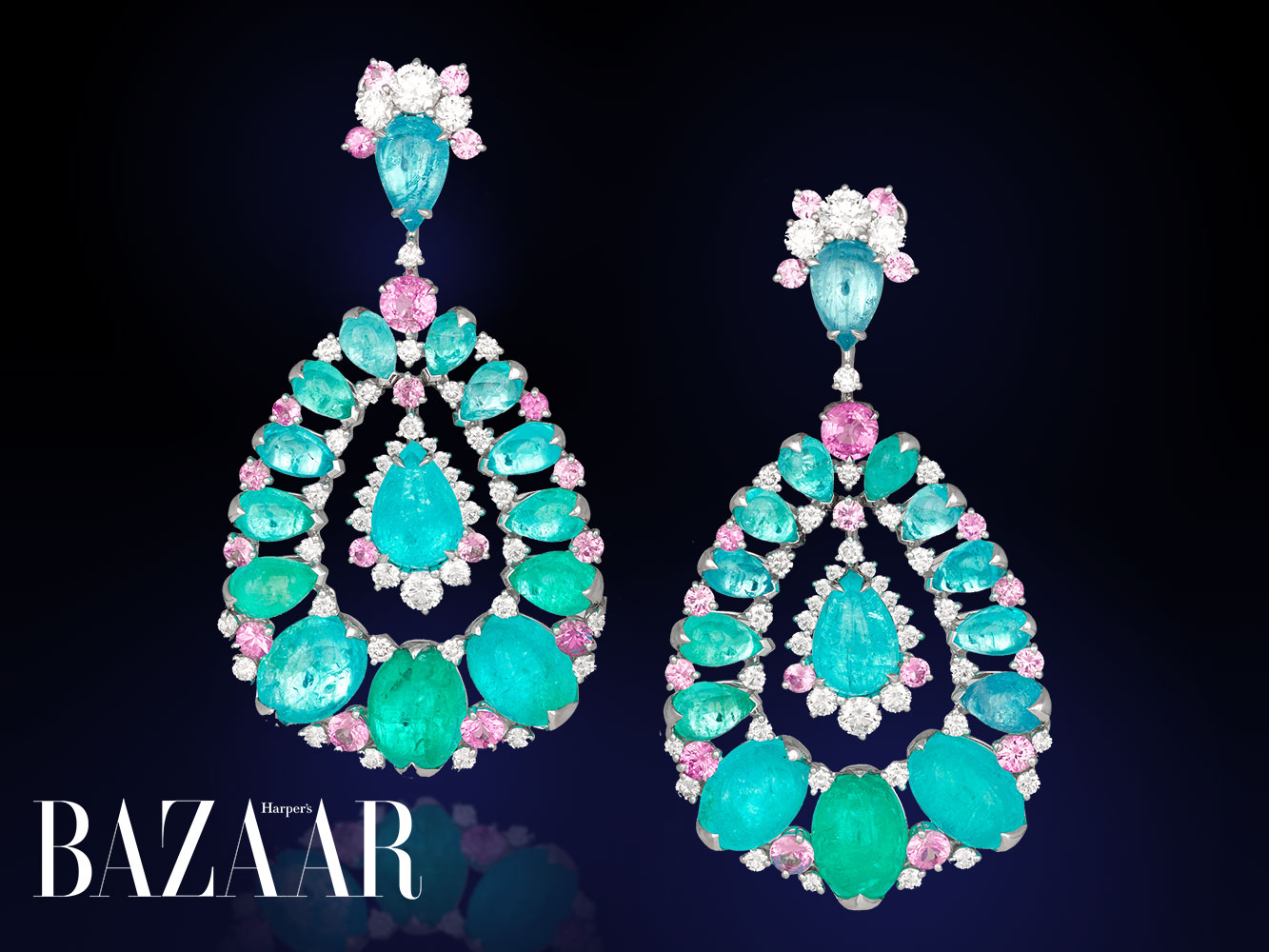
Earrings with Paraiba tourmaline, pink sapphires and diamonds, David Morris
Paraiba tourmaline owes its name to the Brazilian state of Paraiba where it was discovered in the 1980s. Initially found only in small sizes, usually below 3-ct sizes when cut, it was soon discovered in the neighboring state of Rio Grande do Norte, and between 2000 and 2005 in Nigeria and Mozambique.
African Paraiba tourmalines tend to be larger and less included than those from Brazil, but the Brazilian specimens are usually characterized by a richer color saturation and are sold with a well-deserved substantial premium; after all, they are the originals.

Yasifan ring with cabochon-cut Mozambique tourmaline, from Beautés du Monde high jewelry collection, Cartier
The discovery of Paraiba tourmaline was one of the most significant chapters in the history of colored gemstones, and no other gem has ever experienced a value increase of such a magnitude within forty years.
Initially experiencing hesitancy from professional buyers that were suspicious about the origin of the unusual color, subsequently rejected by the broad public that considered the color as looking too kitsch, copper-colored Paraiba tourmaline conquered the world within a short time.

Mizuchi ring with tourmaline and emeralds, from Beautés du Monde high jewelry collection, Cartier
In combination with a strong “electric” brightness, the most valued color is a richly saturated “neon blue”; it is exceedingly rare and most characteristic to the finest gems that originated from Brazil. The other Paraiba hues are less saturated, generally medium- light to light.
If “neon blue” is out of reach, the most popular colors available in the marketplace are represented by slightly greenish blue to greenish blue and blue-green, resembling cyan to turquoise-like colors. Emerald-green Paraiba tourmaline is beautiful, but less valuable than those with a blue dominant.
Pale samples do not qualify as Paraiba tourmalines because they don’t contain enough copper; they tend to look like pale aquamarine.

Earrings with Paraiba tourmaline, pearls, diamonds, tsavorite garnets, and fancy colored sapphires, from Tie&Dior high jewelry collection, Dior
Bright, happy colors, without grayish or brownish tone, are the darlings of the younger generations; they are attracted to vibrant and fluorescent colors, like they constantly see on the screen of their high-tech devices.
ABOUT THE AUTHORRoland Schluessel was born in Switzerland and spent part of his childhood in Milan, Italy. After graduating from business, management, and marketing schools in Switzerland, he studied gemology in Germany and London, Great Britain, where he was awarded the Rayner Prize in 1985. During his numerous travels to the gemstone centers and mining sites in South America, Africa, Europe and Asia, Roland captured more than 200,000 pictures of gem mining, gemstones, and geological processes such as volcanic eruptions. Roland Schluessel resides in San Francisco. Together with his wife Nata, they own the gemstone wholesale company Pillar & Stone International specializing in fine colored gemstones and jadeite. Roland is also the author of a book about Rubies and Sapphires from Myanmar, and co-author of the book Jade, a Gemologist’s Guide. |

Earrings: Neon blue Paraiba tourmalines weighing 7.55 ct and diamonds. Necklace: Neon blue Paraiba tourmaline exceeding 9 carats, surrounded by oval diamonds. All Shreve & Co
ĐỊA CHỈ MUA SẮM: SHREVE & COEstablished in 1852, Shreve & Co. is the oldest retailer in the state of California with locations in downtown San Francisco and Stanford Shopping Center in Palo Alto. As curators of modern luxury, Shreve & Co. is committed to providing an exceptional shopping experience while always creating an opportunity for discovery. Each glance throughout our stores exposes a refined array of handcrafted jewelry and timepieces – a chance to reveal the new and different to those who appreciate the world’s most beautiful things. Shreve & Co. is proud to be home to Rolex, Panerai, Tudor, IWC, Vacheron Constantin, A. Lange & Sohne, Hearts on Fire, Harry Kotlar, Mikimoto and many more. To discover more from Shreve & Co., please email info@Shreve.com to get started. |
OTHER GEMSTONES ARTICLES BY ROLAND SCHLUESSEL:
SPINEL: REVIVAL OF A CLASSIC GEMSTONE
FANCY COLORED SAPPHIRE: COLORS OF THE RAINBOW
BLUE SAPPHIRE: SYMBOL OF SERENITY AND WISDOM
RUBY: THE MOST PRECIOUS OF ALL COLORED GEMSTONES
Harper’s Bazaar Vietnam





